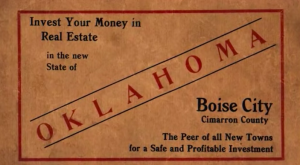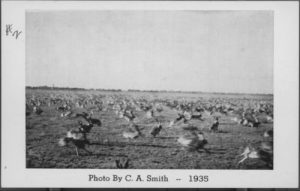The Dust Bowl, the “worst man-made ecological disaster in American history,” is an example of both a spectacle and slow disaster due to the cause and effect relationship leading to the environmental catastrophe (PBS, 3:38). While the spectacular nature of dust storms and wind erosion is clearly shown by the devastated “land, livelihood, and loved ones,” the slow violence present in the Dust Bowl is more convoluted than others we have studied thus far in this course (PBS, 5:20). This section explores the ways that the slow violence seen in the Dust Bowl directly hurt the land and indirectly harmed the people who lived off of it. Furthermore, this discussion requires the acknowledgement that accessing blame in this example is difficult. Due to the context of the crisis, the farmers and their families, who were most affected, unknowingly or ignorantly inflicted harm onto the land for half a century before it ultimately turned against them.
Dishonest Gain
An increased demand for wheat, government encouragement, real estate salesmen and shadow investors, and the “irresistible promise of easy money” prompted people to turn grazing grasslands into wheat farms, ignoring that the land was never supposed to be used in that way (PBS, 3:45). Donald Worster, the author of Dust Bowl: The Southern Plains in the 1930s, declared that the exploitation of land was so severe that a catastrophe of the Dust Bowl’s impact normally took hundreds of years of deforestation, but in 40 to 50 years, Americans “created a world class environmental disaster” (PBS, 4:25). World War I propaganda, such as the phrase “wheat will win the war” and a wheat shortage abroad increased the demand for production (PBS, 16:52). Prohibition policies backfired into excess alcohol consumption which also necessitated grain production. With the Homestead Act of 1862, Kincaid Amendment of 1904, Enlarged Homestead Act of 1909, and Stock-Raising Homestead Act of 1916, occupying land became increasingly possible. The government also supported wheat prices by setting a price floor 1 bushel of wheat at $2; when corrected for inflation, the price would be around $29 today (PBS, 11:43) (“Inflation Calculator”). Increased profits came at the cost of industrializing family farms, operating with mechanical tractors nonstop (PBS, 17:10).

With the government’s blessing, real estate speculators and suitcase farmers added fuel to the fire. Real estate speculators exploited the boom of land value by fraudulently promising that “rain follows plow” (PBS, 16:15). Their ridiculous bias provided misleading information to hard working families and took advantage of the Scotch-Irish, Germans from Russia, and Latinos from Mexico whose goal was to live the American dream and own land (PBS, 15:28). Shadow investors, known as suitcase farmers, furthered land overuse by buying land and hiring farm labor to reap the benefits of increased agriculture while living in cities such as Topeka and Denver (PBS, 11:45). Forgetting that mother nature is stronger than them, farmers sought out the siren song of starting anew, working hard, and enjoying the pay off. Their “heedless actions” generated revenue for some time but ultimately cost them their “crops, cattle and children” (PBS, 3:45 and 14:45). Understanding that the Dust Bowl was a collective action between many groups brings to light the human frailty present and the reason for cycles of booms and busts.
Bad Luck
While humans improperly handled the land, it is important to point out that there were unavoidable causes of the Dust Bowl and its annihilating effects. Prior to the eight year drought beginning in 1931, the stock market crash in 1929 pushed prices down from $2 to forty cents a bushel. The Federal Reserve tried to prevent the asset bubble from bursting in the late 1920s, but nevertheless, it did. The eight year drought could not have been anticipated nor prevented, from occurring which does not justify humans’ reckless behavior but does demonstrate the influence of the inevitable on non-natural problems. The wind gusts were also an unfortunate factor in creating the dust storms, but they had always blown without causing damage, excluding tornados. This changed when farmers converted grasslands with deep roots into wheat farms, resulting in exposed and loose topsoil that was ready to fly.
God’s Punishment
Identifying accountability to one group is not possible nor fair. Instead, this section aims to dissect the slippery slope nature of acting like God and trying to control the environment. Farmers would not have overworked their land if there was not an increased demand for their goods. At the same time, they did not complain about the land use because they were turning profits like never before. Timothy Egan, the author of The Worst Hard Time, pointed out that the Dust Bowl was a result of “human beings pushing too hard on nature and nature pushing back” (PBS, 3:55). Many thought the world was ending with signs of biblical proportions: skies refused rain, families huddled in dark rooms, grasshoppers and rabbits run amuck, angry winds blew dirt, pillars of dirt choked out the sun, and land itself turned against them with lethal vengeance (PBS, 3:00). They asked, “What did we do to deserve this?” (Surviving the Dust Bowl, 2:09). The Dust Bowl is proof that mother nature’s strength will overpower all others, especially human’s actions to control her.


